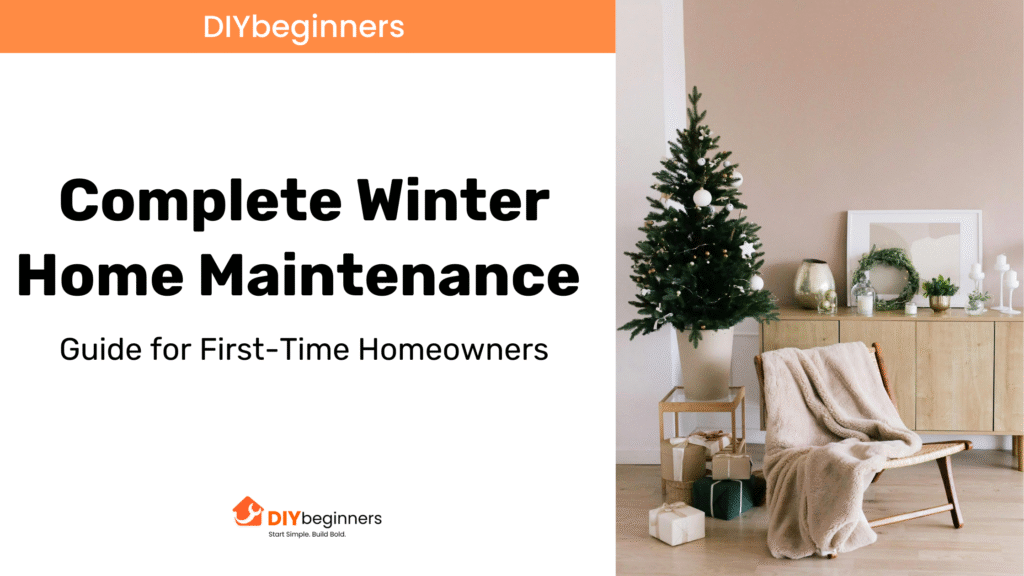
Winter can be worse on your home, and proper winter home maintenance begins with understanding your home’s needs during the winter months. With a drop in temperatures and the first snowfalls, your house has its own particular set of problems that need to be addressed preemptively. Winter home maintenance is a priority meant to prevent the occurrence of emergency repairs that cost a fortune, up to thousands of dollars.
To help you keep your family and your investment safe during the coldest seasons of the year, this guide will help you complete important maintenance tasks. Even as a first-time homeowner or just getting acquainted with winter maintenance, these tried and trustworthy tactics will help get your home winter-ready.
Essential Winter Home Maintenance Checklist Items
The longer winter home maintenance checklist also helps you to prevent the possibility of overlooking important things when preparing your home during winter. The success in ensuring that winter maintenance is done is dependent on how one considers the preventive as well as consistent monitoring during the winter.
1. Heating System Preparation
Your heating system takes the most strain during winter as compared to any other season of the year, and it is therefore important that you maintain it in order to serve the purpose of efficiency and safety. Make sure that you start the heating season with a professional inspection, as experts of both Home Depot and This Old House recommend. This check must come with inspecting the heat exchanger, safety controls testing, as well as the ventilation.
Change the furnace filter once a month during the hot heating season because filthy filters cause your unit to strain and can cause snags. Clean filters also enhance the indoor air quality, which is of particular interest when the windows are closed regularly. In case you own a heat pump, you need to make sure the outdoor unit is free of snow, ice, and debris during the winter.
It would probably pay you to have your HVAC ducts cleaned professionally before winter comes on. Clean ducts make the system more efficient and decrease the level of dust and allergens moving around in your house. Although nothing prevents you from doing this once a year, it can help maintain the optimal functioning of your heating system and the comfort of all your family members.
2. Insulation and Draft Prevention
You can save up to 30 percent of your heating costs by proper insulation and the prevention of drafts by keeping a consistent temperature in the indoor environment. The first step you should take is to insulate your attic depths, which normally falls within the range of 12-15 inches of depth as per the energy standards. When the insulation used is flattened or lacking, a supplement will deliver immediate results.
Go around your house on a windy day and see where you have drafts at the windows, the doors, and other points or openings. Install weatherstripping around the windows and the doors, and seal the holes around the pipes, electric outlets, e, using caulk. These are easy jobs that will really help transform the comfort and efficiency of your house.
Your basement and crawl spaces are not to be ignored either, as cold air tends to come in via foundation cracks or utility holes, even. Sealing these areas will eliminate cold air penetration and limit the chances of frozen pipes occurring in unheated spaces.
Expert Winter Home Maintenance Tips for Success
These winter home maintenance tips come from seasoned pros and homeowners who have learned it the hard way over the years of seasonal prep. Renowned home improvement expert, Mike Holmes, claims that prevention is the much cheaper of the two options compared to emergency repairs.
1. Water System Protection
Preventing frozen pipes is one of the most important winter preservation tasks. Frozen pipes can even break and bring in thousands of dollars’ worth of water damage in a short couple of hours. Put foam insulation around pipes that are exposed to cold in unheated spaces and garages, crawl spaces, and basements.
When there are extremely cold temperatures, do not close off the faucets totally, but you should permit faucets to have low dripping water since flowing water is unlikely to freeze. Leave cabinet doors on sinks open so warm air will circulate the pipes, especially on outside walls. In planning to travel during winter, avoid turning down your thermostat below the temperature of 55°F because this temperature would keep your pipes unfrozen.
Be familiar with the location of your main water shut-off valve, and practice opening it to know how to operate your water shut-off valve quickly in case of an emergency. Make this information readily available and make the rest of the family members aware of its whereabouts. Check out an intelligent water leak sensor that will warn you about the leakage even when you are out of the house.
2. Roof and Gutter Maintenance
The stresses your roof experiences during winter consist of snow loads, the formation of ice, and a change in temperatures. Clean your gutters and downspouts well ahead of winter so that clogged gutters do not result in the formation of ice dams. Ice dams consist of accumulating frozen snow on a roof edge that can back up water into the roof shingles and into a house.
Examine your roof to ensure tiles are not loose and rotten, a nd water cannot get in through gaps during winter storms. Keeping your roof in good condition does not mean much unless you can help prevent a major repair situation before it occurs. Trim any tree limbs that hang over your roof-because ice-laden branches are likely to break and cause major damage.
Consider having roof heating cables installed in places where ice dam formation is likely to occur, such as along the edge of the roof and along valleys, which are likely to catch snow. These cables also serve to sustain an even temperature and avoid the freeze-thaw cycles that result in ice dams.
Your Complete Winter Home Maintenance List
Your winter home maintenance checklist must be adjusted based on the age and condition of your particular house, but there are common tasks that should be done on every house. Creating a timing framework for undertaking these tasks should go a long way in ensuring all these are done before the onset of severe weather
1. Pre-Winter Home Maintenance Preparation Steps
Your pre-winter home maintenance checklist should begin towards the end of fall, preferably in the month of October, when you start experiencing that steady drop in temperature. Such timing will enable you to do all outdoor activities in a comfortable way and solve any problems that might occur before you need an emergency.
Several exterior chores are hard to do or even impossible to do when the snows fall. Clean your chimney in case you have a fireplace (creosote buildup creates fire hazards). Test your smoke and carbon monoxide sensors, replacing even those that appear functional because of old batteries. Carbon monoxide is also generated by the winter heating systems, and thus, detectors are essential for the safety of the family.
Empty and drain all outdoor water hoses, and turn the water off to exterior spigots to prevent freezing. Store hoses in a warm place to remove the possibility of damage from freezing. Winterize your home with an irrigation system through professional services because a home with an irrigation system will not have any problem during spring in terms of high costs on repair work.
2. Fall-Winter Home Maintenance Checklist Essentials
As mentioned, your fall-winter home to-do list should include a one-time readiness preparation, as well as home maintenance procedures. Fill the winter supply, such as ice buster, snow removal appendages, and emergency supplies, such as flashlight, batteries, and non-perishable foods.
Test the backup heating sources, i.e,. Wood stoves, space heaters, or generators may exist. Check the availability of sufficient fuel supply and that all machinery is working safely. Outdoor heating equipment should never be used inside, which can cause deadly carbon monoxide problems.
Set your ceiling fans to run clockwise instead of counterclockwise because the clockwise setting causes the fan to push the warmer air down past the ceiling and make the heating system more efficient. Just this step alone can cut heating bills and enhance comfort in every room in your house.
3. Monthly Winter Maintenance Tasks
Winter home maintenance is seasonal preparation and consistent seeking as winter kicks in and on. Inspect your heating system once every month by listening, or smelling your furnace or boiler, along with examining them visually to find abnormalities. Change filters every four to eight weeks, depending upon heavy-hot-use.
Be aware of the high levels of humidity in your home during the winter since the air is so dry. Dry air might dry out wood floors and furniture, and make your rooms feel even colder than they actually are. A cool mist humidifier may be used to keep the humidity in the range of 30-50 %.
Inspect the exterior of your house once every month during winter to look for signs of ice, broken gutters, and other winter-related problems. Clean snow off around your home foundation and keep vents free of debris and snow.
Conclusion
A thoughtful checklist on winter home maintenance helps to remember about those Cinderella chores so that they do not end up forgotten, leaving your home and family members vulnerable to the changes of winter. A few easy winter home maintenance hints could make a huge difference in your home’s efficiency, the security and safety of a family, and your heating bill.
Winter maintenance is an investment in your home as well as your family and your family’s’s comfort. Your preparations now will save you both time and money in the long run. Whatever effort you put into getting ready before winter hihits tsill be glad you did not have to make emergency repairs and spend less on heating. Prepare in advance, be organized, and never be afraid to seek the advice of professionals on matters you feel technically ill-equipped to handle.
As long as you apply this guide to your particular home and tailor it to the needs of your home, you will be sufficiently ready to face any challenge this winter might bring. By embracing a winter home maintenance schedule well in advance, your family will be kept warm, safe, and comfortable during all the coldest months of the year.
